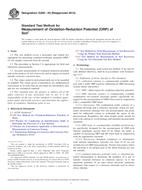Potřebujeme váš souhlas k využití jednotlivých dat, aby se vám mimo jiné mohly ukazovat informace týkající se vašich zájmů. Souhlas udělíte kliknutím na tlačítko „OK“.
ASTM E1688-10
Standard Guide for Determination of the Bioaccumulation of Sediment-Associated Contaminants by Benthic Invertebrates
Automaticky přeložený název:
Standardní Příručka pro Určení Bioakumulace sedimentu spojených s nečistoty bentického bezobratlých
NORMA vydána dne 1.4.2010
Informace o normě:
Označení normy: ASTM E1688-10
Poznámka: NEPLATNÁ
Datum vydání normy: 1.4.2010
Kód zboží: NS-42657
Počet stran: 58
Přibližná hmotnost: 174 g (0.38 liber)
Země: Americká technická norma
Kategorie: Technické normy ASTM
Kategorie - podobné normy:
Anotace textu normy ASTM E1688-10 :
Keywords:
bioavailability, freshwater invertebrates, marine invertebrates, sediment-associated contaminants, sediment bioaccumulation, Contamination--soil, Ecological considerations, Estuarine environments--collecting benthic macroinvertebrates, Fresh water--collecting benthic macroinvertebrates, Health hazards, Infaunal invertebrates, Benthic macroinvertebrates (collecting), Bioaccumulation, Lumbriculus variegatus, Marine environments, Replication, Sediment, Ten-day testing, Time to steady-state
Doplňující informace
| Significance and Use | ||||||||||||||||||||||||||
|
Sediment exposure evaluations are a critical component for both ecological and human health risk assessments. Credible, cost-effective methods are required to determine the rate and extent of bioaccumulation given the potential importance of bioaccumulation by benthic organisms. Standardized test methods to assess the bioavailability of sediment-associated contaminants are required to assist in the development of sediment quality guidelines (1, 2, 3) and to assess the potential impacts of disposal of dredge materials (4). The extent to which sediment-associated contaminants are biologically available and bioaccumulated is important in order to assess their direct effects on sediment-dwelling organisms and assess their transport to higher trophic levels. Controlled studies are required to determine the potential for bioaccumulation that can be interpreted and modeled for predicting the impact of accumulated chemicals. The data collected by these methods should be correlated with the current understanding of toxicity or human health risks to augment the hazard interpretation for contaminated sediments. |
||||||||||||||||||||||||||
| 1. Scope | ||||||||||||||||||||||||||
|
1.1 This guide covers procedures for measuring the bioaccumulation of sediment-associated contaminants by infaunal invertebrates. Marine, estuarine, and freshwater sediments are a major sink for chemicals that sorb preferentially to particles, such as organic compounds with high octanol-water-partitioning coefficients (Kow) (for example, polychlorinated biphenyls (PCBs) and dichlorodiphenyltrichloroethane (DDT)) and many metals. The accumulation of chemicals into whole or bedded sediments (that is, consolidated rather than suspended sediments) reduces their direct bioavailability to pelagic organisms but increases the exposure of benthic organisms. Feeding of pelagic organisms on benthic prey can reintroduce sediment-associated contaminants into pelagic food webs. The bioaccumulation of sediment-associated contaminants by sediment-dwelling organisms can therefore result in ecological impacts on benthic and pelagic communities and human health from the consumption of contaminated shellfish or pelagic fish. 1.2 Methods of measuring bioaccumulation by infaunal organisms from marine, estuarine, and freshwater sediments containing organic or metal contaminates will be discussed. The procedures are designed to generate quantitative estimates of steady-state tissue residues because data from bioaccumulation tests are often used in ecological or human health risk assessments. Eighty percent of steady-state is used as the general criterion. Because the results from a single or few species are often extrapolated to other species, the procedures are designed to maximize exposure to sediment-associated contaminants so that residues in untested species are not underestimated systematically. A 28-day exposure with sediment-ingesting invertebrates and no supplemental food is recommended as the standard single sampling procedure. Procedures for long-term and kinetic tests are provided for use when 80 % of steady-state will not be obtained within 28 days or when more precise estimates of steady-state tissue residues are required. The procedures are adaptable to shorter exposures and different feeding types. Exposures shorter than 28 days may be used to identify which compounds are bioavailable (that is, bioaccumulation potential) or for testing species that do not live for 28 days in the sediment (for example, certain Chironomus). Non-sediment-ingestors or species requiring supplementary food may be used if the goal is to determine uptake in these particular species because of their importance in ecological or human health risk assessments. However, the results from such species should not be extrapolated to other species. 1.3 Standard test methods are still under development, and much of this guide is based on techniques used in successful studies and expert opinion rather than experimental comparisons of different techniques. Also, relatively few marine/estuarine (for example, Nereis and Macoma), freshwater (for example, Diporeia and Lumbriculus variegatus) species, and primarily neutral organic compounds provide a substantial portion of the basis for the guide. Nonetheless, sufficient progress has been made in conducting experiments and understanding the factors regulating sediment bioavailability to establish general guidelines for sediment bioaccumulation tests. |
||||||||||||||||||||||||||
| 2. Referenced Documents | ||||||||||||||||||||||||||
|
Podobné normy:
Historická
1.11.2013
Historická
1.9.2009
Historická
1.2.2008
Historická
1.11.2012
Historická
1.2.2008
Historická
1.5.2014
Odebírejte informace o nově vydaných normách ZDARMA:
Chcete pravidelně odebírat informace o nově vycházejících normách z celého světa a to zcela zdarma?
Přihlašte se k odběru. Vše je velice jednoduché a absolutně ZDARMA.
Na výběr máte vydavatele z celého světa.



 ASTM D5435-13
ASTM D5435-13 ASTM D5929-96(2009)..
ASTM D5929-96(2009).. ASTM E1525-02(2008)..
ASTM E1525-02(2008).. ASTM E1676-12
ASTM E1676-12 ASTM E2172-01(2008)..
ASTM E2172-01(2008).. ASTM G200-09(2014)..
ASTM G200-09(2014)..
 Cookies
Cookies
